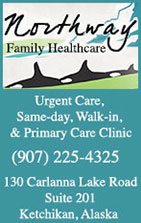
A snapshot of Ketchikan in 1910Local pamphlet was developed to boost mining industryBy DAVE KIFFER
April 19, 2019
When more than 100 residents signed the town Articles of Incorporation in 1900, nearly all of them had some connection to the mining industry. The hills around Ketchikan were riddled with potential mine sites as the prospective "mother lode" finders hoped to discover gold the area's seeming endless quartz veins. Unfortunately the Ketchikan geology did not contain vast gold resources like Juneau or Fairbanks or Nome. Other industries, primarily salmon canning and timber and eventually tourism would have to rise to keep Ketchikan from turning into another Alaskan ghost town.
Mining history is not something that we trumpet today. Ketchikan is known for its Native culture and its salmon and for the fact that more than one million cruise passengers visit each summer. Back in 1910, there were indeed tourists and salmon and Native culture, but the primary economic engine of Ketchikan was still the mining industry, although it was on the down swing and that had local officials concerned. A significant drop in copper prices in 1907 had shut down many of the largest mines in the area, especially the bigger ones on Prince of Wales for which Ketchikan was the primary supplier. By 1910, the copper industry hadn't come back and that inspired the powers that be to try to prime the pump a little. In much the same way that the closure of the Ketchikan Pulp Mill in 1997 would inspire efforts to "promote" the timber industry to outside interests, in 1910 there was an effort to do the same with mining.
A pamphlet was produced called "Ketchikan: First City in Alaska." Ostensibly it was to promote Ketchikan, but it also focused on mining in the area, noting the big mines and heralding Southern Southeast Alaska as one of the great untapped mining areas in the Territory. The pamphlet also focused on the amenities Ketchikan offered and why it would make a good place to come to live. It was community boosterism at it's finest, replete with a little over-the-top verbiage. "At the foot of a magnificent mountain, whose snowy brow seems ever raised to kiss the sky, stands Ketchikan, the First City in Alaska," the pamphlet begins. "Down this mountain pours a stream of sparkling water that is piped to every home and business house, furnishing a supply cool almost to iciness the year round." The pamphlet goes on to note that the water drives the ""water wheels" of industry and that Ketchikan Creek is "populated to congestion" with salmon and trout. "Ketchikan is rapidly becoming known as a tourists' paradise, for the scenery here is more magnificent than elsewhere," the pamphlet goes on. "The hunter and the fisher are learning that our hills and streams are the natural homes for deer, bear, mountain goat, wild fowl, fish, clams and crabs." But then the pamphlet abruptly shifts to its main concern. "But it is not to the pleasure-seeker alone that Ketchikan offers the greatest inducements," it continues. "To the mining man we offer opportunities that few countries possess. The mines of this district are foremost in offering treasures to those who have the foresight to secure them, and the undiscovered ore deposits are scattered all through the hillsides, awaiting the prospector. Much gold and copper has been discovered but it is a handful compared to the riches that are untouched." The pamphlet also goes on the promote the nascent timber industry as well, noting that "to the paper manufacturer the Ketchikan District offers more natural resources that New York or Wisconsin ever did." There is also a nod to the fishing industry, particularly the then strong halibut fishery noting that "thousands of tons of fish are taken each year" from the area. And if you just want to live in paradise, just come on up. "The home seeker never had a more promising spot upon which to build a home and carve out a happy future for himself and family." The pamphlet then goes back into Ketchikan's early history, some three decades before. We are reminded that first Anglos to come here in 1886 were looking for fishing industry opportunities but they noticed "some very fine gold bearing rock" and "soon the miners began pouring in." Considering the Ketchikan population was barely in the hundreds in the 1890s, the miners must have been "pouring in" somewhat slowly, but the 1898 Klondike Gold Rush did bring many more people to the Territory at the turn of the century. With many of those prospectors being unsuccessful in the Klondike, they fanned out to other parts of the Territory looking for gold. Quite a few ended up in Ketchikan. By the time the pamphlet was produced a decade after the Gold Rush Ketchikan's year round population was 1,500 but "during mining activities that number is increased by several hundred." The pamphlet then offers some US Geological Survey information to further encourage people to come boost the local mining industry. The info noted that gold had been found at Helm Bay on the mainland, at Sealevel on Revillagigedo Island and at Dolomi on Prince of Wales Island. It also noted significant copper deposits at the Kasaan Peninsula, Copper Mountain and Niblack. It then goes on to say that gold is the only mineral found in commercial quantities in the region, which - even by 1910 - was known to be false. Southern Southeast Alaska's geology was much more conducive to commercial amounts of copper than to gold, but with the copper industry in the doldrums at that point, the producers of the Ketchikan pamphlet were clearly trying to raise a little "gold fever." The pamphlet does go on to provide some interesting information about the mines the operating in the region, particularly the ones on Prince of Wales Island. It notes that several operators are raising capital to extend their underground operations, some up to a depth of 2,000 feet. It notes that the copper mines still have significant resources. "What is needed is a little outside money to put them on a shipping basis," it notes hopefully. The importance of Prince of Wales to the Ketchikan economy is made clear as several pages of the pamphlet are devoted to mines on both the east and west coasts of the big island. This may also be a nod to the fact that POW has a different geology than the Revillagigedo and the locals were clearly aware that there were simply more commercial grade lodes on the other side of Clarence Strait. Unfortunately, history would prove that efforts to turn Southern Southeast in a mining district comparable to Juneau would not pan out. While Juneau continued to hum along on the strength of its massive gold mines at least until World War II, the exploration in the Ketchikan area simply never paid out. The community, instead, turned to the salmon canning industry that drove it for the next four decades.
Over time, there have continued to be various mining ventures in the Ketchikan area, but few have been ultimately successful. Marble and uranium were both mined on Prince of Wales. One of the world's largest molybdenum deposits was found in Misty Fjords but never developed. Two significant mines remain "on deck" on Prince of Wales, a "rare earths" mine at Bokan Mountain and a gold and silver mine at Niblack. But beyond the historical snapshot of what Ketchikan's mining industry looked like in 1910, the pamphlet also gives a tantalizing picture of the commercial life of the community that year. There are more than 16 pages of business advertisements of companies clearly supporting the mining proponents. They represent a "who's who" of early Ketchikan. W.F. Schlothan's Northern Machine Works is included and Tongass Trading Company's "Big Store" and Ketchikan Draying. The Pacific Coast Steamship Company offers "summer cruises and excursions." Charles Ingersoll and Charles Cosgrove put out their attorney shingles. N.F. Zimmerman's store offers "gum boots, Ladies and Gents Rubbers and a fine line of Gents Furnishings."
P.J. Gilmore is a "dealer" in clothing furnishings, boots, shoes, hats and caps. E. Verney's "Metlakahtla Art Store" at the end of Mission Street offers fruits, canned salmon, canned clams and canned venison, all "in glass" as well as "Indian moccasins" and other art. J.P. Whitcomb Jeweler says "repairing is a specialty." C.B. Lancaster offers his gasoline cruiser "Taku" for hire at $2.50 per running hour and $15.00 per layover day. Ryus Drug offers a complete line of "drugs, chemicals, patent medicines and druggist's sundries" as well as "Edison and Victor Talking Machines." J.R. Heckman notes that it carries $75,000 in general merchandise and is particularly suited to service the mining industry. Local fun and games are also noted in the advertisements. Hunt and James advertise a bowling alley with "billiards, pool, cigars and tobacco." J.W. Sayles advertises the "Elite Skating RInk." H.C. Schmidt has a "Bakery and Confectionary." H. G. Kubley's Confectionary Store offers "Stokes' Seattle Ice Cream and Superior Chocolates." Ketchikan, in 1910, was clearly trying to market itself to outsiders as a growing young community where outsiders could establish themselves without giving up the comforts and services of "home," wherever that may be. The mining industry continued to be a "player" in the local economy until World War I restrictions closed nearly all of the still operating mines. By the time the war was over, the salmon canning industry was on the rise and soon Ketchikan would have a dozen canneries operating. Mining's time as a major industry in the First City would be past but the community would live on.
Related:
On the Web:
Contact Dave at dave@sitnews.us Dave Kiffer ©2019 Publication fee required. © Representations of fact and opinions in comments posted are solely those of the individual posters and do not represent the opinions of Sitnews.
|
|||||||







